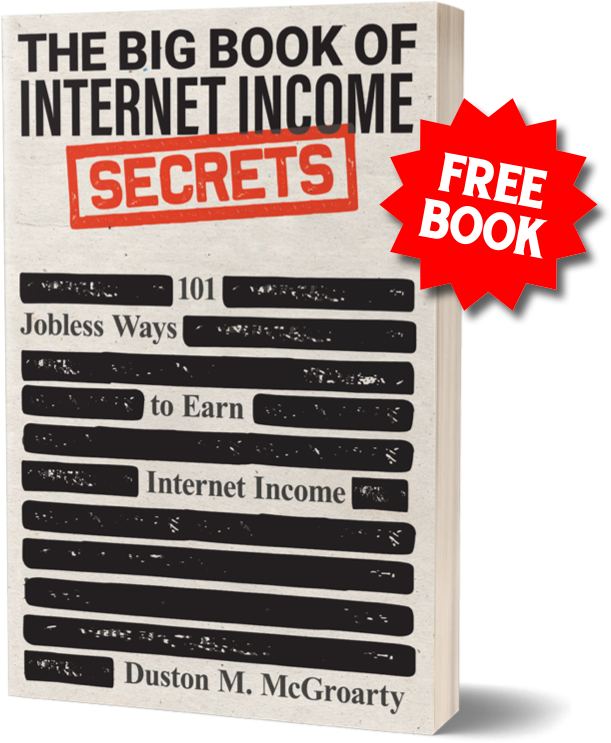There’s just something about discovering these little automated money streams that gets me all excited inside.
Without further ado, lets get started.
Which SEO Tool Is Best?
This is probably the most asked question I get from people interested in this business model.
Honestly, folks, it doesn’t really matter.
Many of them will get you the answers you need, the information you’re looking for, and the head start required to push forward.
Really though, it comes down to what you really NEED to know. And for what you’re doing you need the following:
- Monthly search volume
- Competing results
- Backlink research on competing 1st page results
Those are the three biggies.
Of course, each of the tools you’ll see below offer their own unique features and benefits and those are great… they’re just not required for what you’re doing here.
So which one is best?
Well, if you went through the free workshop… you already know my recommendation… SEMrush.
To me it has the most features for the price, even at the $99/mo price point.
Use that link above for a free 7-day trial. They don’t offer trials if you go straight to their website.
Alright, below you’ll see that I put together a spreadsheet of some of the top SEO tools out there.

Now, at a glance you can see what I feel to be the necessary information when deciding which tool to go with.
I know many of you are wondering how important the backlink research really is when it comes to choosing one of these tools and if there are any free alternatives.
When it comes to competitive research, getting as much information as possible about the 1st page rankings is essential. Backlinks are a huge factor of that.
There are free alternatives but they’re very limited as to what information they reveal because they want you to sign up for their paid service.
The backlink info you’re after is more detailed than just how many backlinks the site has. What’s more important is, where exactly are their links coming from, what’s the authority of that site, what’s the anchor text used for the backlink, and where exactly are the backlinks pointing to.
And, yes, you can get all of that information from SEMrush.
So… I’ll be using SEMrush for the remainder of this training but don’t feel obligated to do the same. All of the tools above will return similar keyword research and will work just as well. Here we go…
How to Really Dig Deep and Find Hot Money Keywords
I’m no rocket scientist for discovering this “method”.
I first started thinking about this stuff back in October 2013 during Ryan Deiss’ mastermind meeting.
Perry Belcher was talking about how they were using this exact method and quickly ranking. They were using the tool WordTracker to sort longtail results by least amount of competition and highest amount of search volume.
My Dad used WordTracker years before that so I figured I’d sign up for it again and try it out. It worked okay for us. I was able to find about 20 potential phrases that I eventually had content created for by outsourced writers.
Problem was, WordTracker’s functionality was VERY limited. The search volume numbers were extremely inaccurate and there was no real way to do any kind of competitive research on these longtail phrases.
Then, at Ryan and Perry’s Traffic & Conversion Summit in 2014, I stopped at one of the vendor booths for this company called SEMrush. That was the first time I heard about them and what they could do.
The guy at the booth showed me a live example and from that moment on I’ve been a subscriber to their service.
But I still wasn’t getting great results with it. I found some great keywords but it took me HOURS.
I was thinking about it one day and wondered if I there was an easy way to find longtail keywords with low competition using SEMrush.
I decided to spend some time in there messing around with their features. That’s when I stumbled onto their Advanced Filters.
It was exactly what I was looking for. After spending a few hours messing around with these filters I was able to determine what the “best” settings were.
Here’s what I landed on…
Step 1
Enter a broad keyword to start. You don’t want to enter a longtail keyword to start with or you won’t get many results to filter. It’s better to start broad (1 or 2 word phrases) and then use the advanced filters to really narrow the results.
Step 2
Change your results to Phrase Match. This ensures that all the words you used to search with are included in each result that’s returned. If you’re not getting anything that you expected to get, you can try to click the Related Keywords tab to find other related phrases that might have higher search volumes.
Step 3
Click the Advanced Filters option. If you get a lot keyword results returned, it’s best to use all three of my filters that you see below. If these three filters cut the list down too far, try removing the Results filter to see if there are any keywords that you could possibly rank for.
The three filters I use are:
- Keyword phrases with more than 2 words
- Keyword phrases with a search volume of 3,000 searches per month or more
- Keyword phrases with less than 600,000 search results
Your screen should look similar to mine below:

Once you’re happy with the filters you’ve set, hit the green Apply button.

You can see my search results went from 15,369 down to 13 just like that. Can you imagine how long it would’ve taken me to go through 15k keywords? Hours and hours and hours. Ask me how I know.
Step 4
In this case, these keywords are worthless to me. I was really looking for phrases related to growing grapes. So I’ll go back up to the very top and refine my initial search from ‘grapes’ to ‘grow grapes’.

Now I only have 252 keyword phrases to start with and they’re much more relevant to what I’m looking for. But, you can also see none of them have more than 2,400 searches per month.
Again, there’s no law saying you can’t rank for a keyword phrase unless it’s 3,000 searches per month or more. That’s your call. I have people writing articles for me for keyword phrases with less than 200 searches per month.
It just depends on YOU and what you’re comfortable with. So, to get these 252 results cut down to a more manageable list, I’ll use the following filters:

I really just omitted the volume filter because they were all already under 3,000. Now, in this case I could’ve set a volume filter going the other way… only show keyword phrases with a search volume that’s greater than 90.
That would’ve only returned four results and those are probably the only four I would consider going after. It really would only be three because two of those four results are the same topic… ‘growing muscadine grapes’.
Now, you’ll want to keep a running list of your potential keywords. You’ll likely do a number of different searches around the same topic so you don’t want to lose any of these potential money-makers.
I like to do each phase of this process independently from the other so I can find a good stopping point if I have to and be able to pick it up right where I left off without losing track of what I did and didn’t do.
In this example, I would create a new Evernote note called Grape Keywords and organize it like this:

By organizing it this way you know what broad keywords you’ve searched, which keywords you’ve found as potential money keywords, and how many searches per month each keyword has.
You can also use a spreadsheet to keep track of these… whatever you prefer. Once we start researching each keyword it helps to put everything into a spreadsheet just to be able to quickly analyze the data but it’s not necessary.
An important note: the idea here isn’t to find as many possible keyword phrases as you can. Remember, you want four or five GOOD keyword phrases that you have a good chance of ranking for. It’s not a volume game here.
You’re going to be focusing A LOT of time and energy into each one of these keywords. The reward is, if done correctly, each one of these keywords will make money for you each and every month for years to come… with very little upkeep from you.
Step 5
The next step is to analyze the 1st page results for each of the keywords. We’ll do that by heading over to Google and entering each keyword, one at a time, in quotes like you see below:

The first thing to do is to make a note of the number of results each Phrase Match keyword gets. Phrase match means, how many pages have that phrase somewhere on them. In this case it’s 73,900.
Notice how different this number is from the one SEMrush gives you? They told me it had 520,000 results. When I do my Google search WITHOUT the quotes around the phrase, it shows 490,000… which is much closer to SEMrush’s number.
Next, you want to look at each of the top 10 results. This part is somewhat challenging for beginners but you’ll catch on pretty fast. You want to see how many of these results you can outrank with a high quality, lengthy, and detailed piece of content.
Now, I’m at the point to where I never even have to click any of these listings to figure that out. I can look at the domain name, the titles, dates posted, and their description and determine if I can outrank them within a minute’s time.
Here are a few things I look for that immediately tells me I can rank with a good piece of content. If any of the 1st page results are:
- Forum threads/posts
- Free web page builders like Weebly, Blogger, Tumblr, or WordPress.com
- Any kind of social media pages like Facebook, LinkedIn, Twitter, Digg, StumbleUpon, Google+, etc.
- Free content sharing sites like Slideshare, Hubpages, Squidoo, or Scribd
Even if there’s just ONE 1st page listing that includes ANY of those items above… I can pretty much guarantee I’ll end up on page 1 eventually. Yes, eventually… not overnight. Not tomorrow. Maybe not next week or next month. Eventually.
Sure, I’ll hit the first page for some things pretty quick and others it’ll take months. Doesn’t matter to me. I’m building a life-long asset here and it requires very, very little money to build such an asset.
Most assets like this require you dump thousands and thousands of dollars into them to be able to get a return like this. It’s an amazing opportunity for those who take advantage.
Lets look at the 1st page results for my grape example. As you can see below, there are two Pinterest pages ranking and one forum page ranking:

I can get on the 1st page pretty easily for this one.
Now, you might be wondering why. Why can you get on the 1st page so easily if there are one or more of those items above ranked on the 1st page?
Two words… User Satisfaction.
Google’s mission is to deliver the best possible content to their users as quickly as possible. Period. End of story.
Go back up and look at those items I listed again. How many of them do you think would satisfy the user and provide them with the answer they’re looking for?
Very few, right? The social media pages, the Pinterest results, forums… they might have that exact keyword phrase somewhere on their site but the content is probably horrible, if it’s even present.
So many people have used these free site builders and social media sites to spam the search engines that Google just doesn’t consider them to be as authoritative any more.
Which tells me, if THEY’RE ranking on the 1st page… I’ll have no problem.
So, unless I see at least ONE of those items ranking… I won’t proceed with that keyword. Not because it isn’t possible to rank, but because it will be more difficult to rank.
If you follow these guidelines, it’s very probable that you won’t even need more than ONE backlink to each article on your site… and in many cases you won’t even need any.
Getting relevant backlinks just super-charges your efforts at that point.
Step 6
Once you’ve found a “winner”, then you can add that to a spreadsheet. Organize it like the one I created below:

We’ll use the Avg Word Count and Avg Backlinks columns in the next step. Once you’ve researched each of your keywords following the steps above, you can move on to the final research phase… competition.
Time for Some Down & Dirty Competition Research
At this point, you should already have a pretty good idea of whether or not you can rank on the 1st page for your desired keyword phrase.
This last step of the research phase is really more to get you ready for the actual content creation process.
You’ve already “vetted” your keywords, rather quickly I might add but I promise you it’s effective. And, if for some reason I’m wrong… this next step will make you aware of it pretty fast!
It’s actually just basic common sense but I’ll be the first to admit, I never thought about doing this. In its simplest form, you’re going to look at each of the ten page 1 results for each of your keywords.
There are two ways to do this:
- You can click through to each page and keep a spreadsheet of all of this data…OR…
- You can print out each page and actually write the data on each printout
I like both methods but printing them out is cool because you can lay them all out on the floor, in their ranking order, and see how they compare.
I would still put all of the data into a spreadsheet because I’m an analytical maniac and that’s what I do.
Here are the data points you need to research for each ranking page:
- Word count
- Keyword density
- Number of backlinks to that specific page and to the entire site
- Number of backlinks to the entire site
- Age of the domain name
- Age of the content
- Are there images in the content… if so, how many? What about other media?
- The social share count of that specific page
Those are the biggies.
It seems like a lot but you’ll get quick at this. It’ll become second nature to you before long. The sad part is, once you start doing this, you can never not look at a web page and start analyzing it for SEO.
I’ll briefly go over each item.
Word Count
What’s important is the word count of just the actual content—not the entire page including sidebars, headers, etc. So just highlight the content, copy it, then paste it into an online word counting tool like WordCounter.net.
Make a note of the word count and move on to the next item.
Keyword Density
With the competitor’s page open in your web browser, do a ‘Find’ search and type in your keyword phrase and see how many times it appears on the page. To find the actual keyword density percentage… take the number of occurrences and divide it by the word count of the page. Make a note of that percentage.
Backlinks to the Page
You can quickly get this number by pasting the entire URL into SEMrush’s search bar at the top and choosing Domain Overview. You’ll find that many pages will have zero backlinks, which is great for you!
Backlinks to the Entire Domain
Same process as above but just put the root domain into the SEMrush search bar. Just make a note of the total backlinks.
Domain Age
This one is easy, just enter the domain name here and make a note of the creation date of the domain.
Content Age
This one is a little more difficult. Copy the URL of the web page, go to Google and paste the URL in the search box after typing ‘inurl:’ first. Hit enter and you should see a date next to the article.
Sometimes you can find a date right on the article page but a lot of times those aren’t the original publication dates… it could just be the date it was last updated.
Image Count and Other Media
Pretty self-explanatory but I also like to see if the images look to be their own unique images or stock photos. If you really want to dig deep, there’s a tool TinEye.com that will tell you if that image has been used anywhere else online.
Also, make a note if they have a video, or audio, or infographic, or any other kind of media embedded on their page.
Social Share Count
Google takes this into account when ranking albeit, it’s not much of a factor any more since anyone can go to Fiverr and buy “Like” and “Pins” and “Views”. This tool right here will get you those counts.




